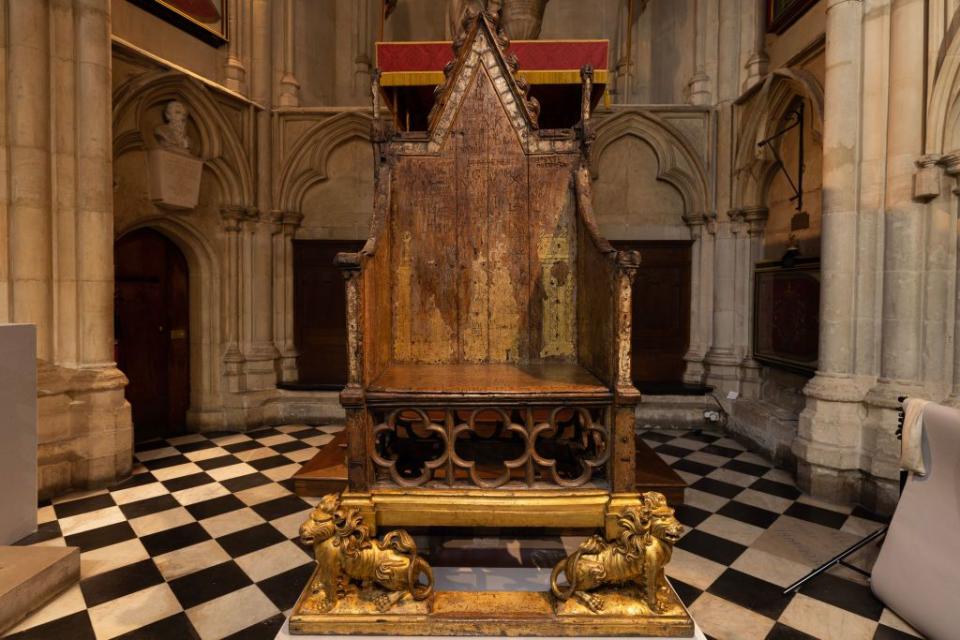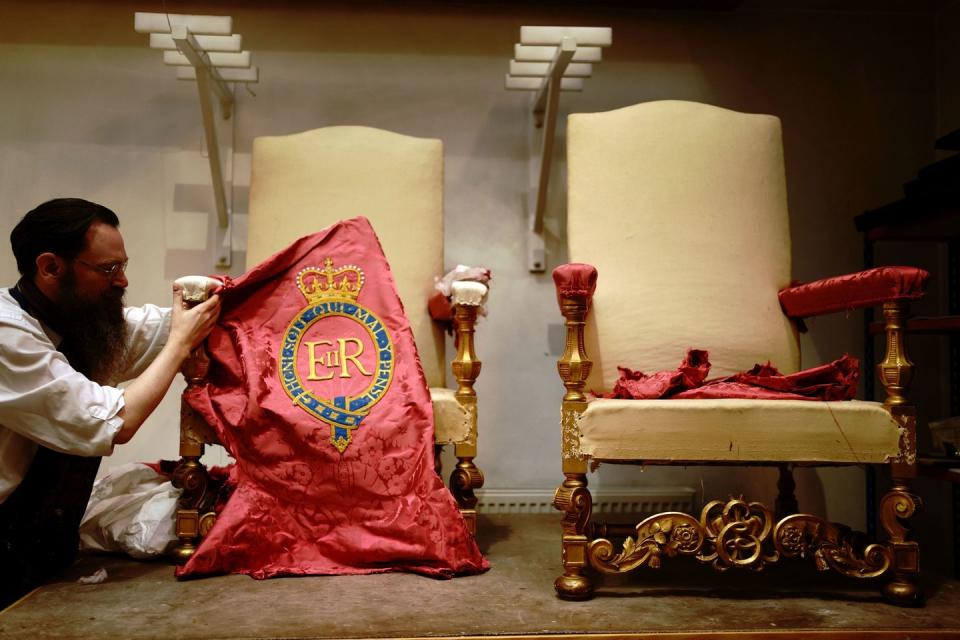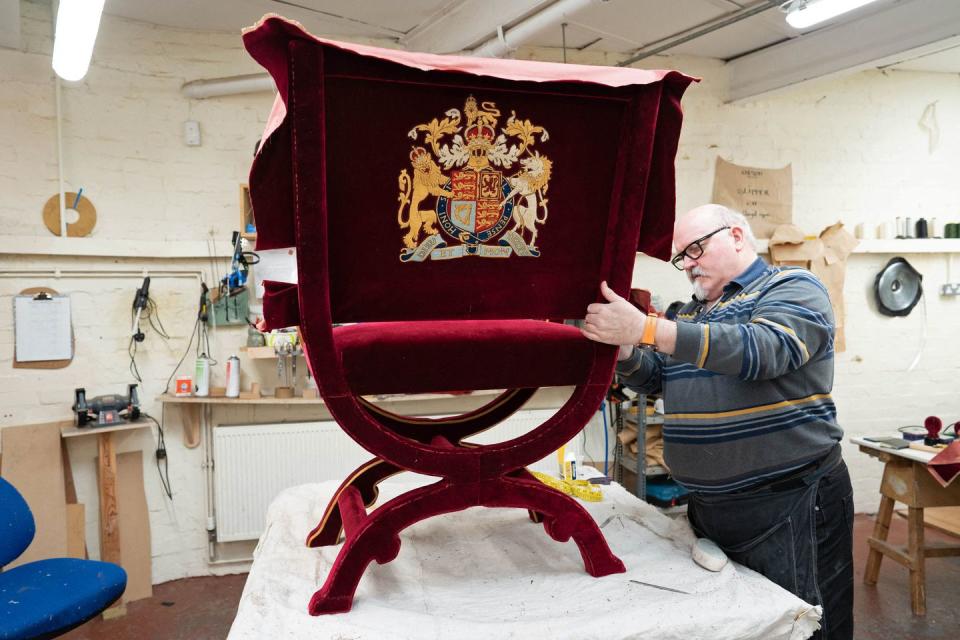Everything You Need to Know About the Thrones Used on Coronation Day
- Oops!Something went wrong.Please try again later.
When Charles III is crowned king of the United Kingdom Saturday, he will be embarking in a centuries-old tradition, filled with obscure rites, glittering regalia, and—of course—plenty of pomp and circumstance. On coronation day, history is also quite literally part of the furniture. In fact, several different types of chairs will be used throughout the different stages of the coronation ceremony—not just a single throne as may be commonly thought. Each kind of seat comes replete with its own symbolism, heritage, and creative backstory. There’s a sustainability angle at play here too, according to the Royal Family’s website. Rather than remake some of the customary furniture, the King and Queen Consort have opted to simply restore what’s already on hand in the royal collection. But make no mistake, they are no less opulent. Read on to discover more about each of these enthralling thrones.
St. Edward’s Chair a.k.a. The Coronation Chair
Year Made: c. 1300
What It’s Used For: The Crowning

This brittle-looking chair may look like something you’d discover in a local yard sale, but it’s, by far, the most important throne in the coronation day proceedings. It is on this centuries-old seat, in the center of Westminster Abbey and before the High Altar, where Charles III will be crowned king. The gothic-style coronation chair was first commissioned by Edward I at the turn of the 14th-century to contain the Stone of Scone, a sacred, 336-pound hunk of sandstone (not to be confused with the buttery teatime treat) which he swiped from the Scots to place in Westminster Abbey.
In its day, the Baltic oak throne was painted with elaborate scenes of birds, animals, and leaves, and also featured a regal image of a king with his feet atop a lion. The chair was first used in a coronation ceremony in 1308 and became the definitive coronation hot seat starting in 1399, with the coronation of Henry IV. Over the ensuing seven centuries, the medieval chair inevitably suffered wear and tear, notably from Victorian schoolboys, who would scratch their names into it while on field trips to the Abbey. A 1914 bomb attack even lopped off a corner. Today, it lives in St. George’s chapel where it underwent a complete restoration in 2012. A recent round of meticulous conservation has taken place in preparation for King Charles III’s coronation.
The Chairs of the Estate
Year Made: 1953
What They’re Used For: Early parts of the service and the Queen Consort’s coronation

This handsome pair of 17th-century style chairs was first created for Queen Elizabeth II’s 1953 coronation. Only the Queen’s chair was used for the ceremony itself, but the set sat together in the Throne Room of Buckingham palace for decades. The beechwood seats were first fabricated by the London furniture makers White, Allon, and Company and feature ornate, gilt bases carved with a thistles, roses, and shamrocks (emblems of the United Kingdom), as well as the cyphers of Queen Elizabeth II and Prince Philip. King Charles opted to reuse the frames and the thrones were sent to conservators from the Royal Collection Trust to be carefully updated. The upholstery was completely redone and the fabric was replaced with lustrous new red silk damask, courtesy Humphries Weaving Company, a firm noted for its restoration work. Meanwhile, the Royal School of Needlework (an institution that has worked on coronation embroidery since 1872 and is based in Hampton Court Palace) worked to create new cyphers for Their Majesties in vibrant-colored thread (Elizabeth and Philip’s originals will be conserved in the Royal Collection). “When we transfer complex designs, we use a method called ‘prick and pounce’ which is the most accurate way of transferring a design to fabric, ready for stitching,” Anne Butcher, head of studio and standards at the Royal School of Needlework tells ELLE DECOR.
“One of the hallmarks of the RSN is that the embroiderers can work collectively on a project, yet it will look like the work of one person,” she explains. “So when a project has a deadline, the RSN has an approach of ‘Never a seat shall go cold.’ All our stitchers are trained to stitch the hand embroidery techniques in the same way so that means when one person gets up, another person can take over and the work will look the same as though done by the same person.”
The Throne Chairs a.k.a. Chairs of State
Year Made: 1937
What They’re Used For: The Enthroning and Homage

One of the most important parts of the ceremony is when, freshly crowned, King Charles III will take his seat in his throne, after which he will swear his oath to the Church of England. For these portions, the King and Queen Consort will take a seat in the throne chairs, a pair of two crimson X-framed seats emblazoned with their coats of arms. These velvet-clad beauties—in a 17th-century style with Tudor inflections—were first made for George VI’s 1937 coronation.

Expert embroiderers from the Royal School of Needlework, once again, lent their skill, first lightly cleaning His Majesty’s coat of arms and then gingerly removing it and backing it with new velvet. “The coat of arms was secured throughout and edged with specially selected colored threads so that the embroidery blended with the new velvet,” Butcher explains. “This is a technique we use quite regularly to ensure embroidery survives.” A new coat of arms, meanwhile, was stitched for the Queen Consort. Conservators replaced the opulent red velvet, trimmings, and braid so that the chairs will look good as new on coronation day.
“Their Majesties came to visit our Embroidery Studio and see the work in progress on the chairs which was lovely to be able to share with them,” Butcher reveals. “We were able to show both the restoration and the new pieces underway. They were particularly interested in the different techniques we had used.”
Congregation Chairs
Year Made: 2023
What They’re Used For: The audience

Though the ceremony chairs for Their Majesties are all repurposed from the royal collection, one hundred VIP members of the Westminster Abbey congregation will sit in brand new ones. These seats feature more streamlined designs, but are no less opulent, with their blue velvet upholstery and stitched cyphers. The chairs were made by furnituremaker (and royal warrant holder) N.E.J. Stevenson in partnership with the royal household and the Prince’s Foundation. “We were delighted to be asked,” Neil Stevenson, the company’s owner and managing director, tells ELLE DECOR. “Unfortunately, time was not on our side as it was not until mid-February that we received the go ahead to manufacture, giving us and the royal household upholsterers only 11 weeks to complete.”
To meet the tight deadline, the artisans at N.E.J. Stevenson kept the design simple (each has a square seat and elegant, tapered leg) and made sure to manufacture the frames first so the upholsterers could get to work. “The first batch of chair frames was delivered to Windsor on the 21st of March with subsequent deliveries over the next two weeks,” Stevenson reveals. “This was an amazing achievement from the staff who exceeded all expectations in giving the upholsterers as much time as possible to complete the work, with a week to spare.”
In keeping with King Charles’s III’s interest in sustainability and traditional British craft, each was made from sustainable oak and six were made by student furniture makers who are part of the Snowdown School of Furniture at Highgrove. And even if you didn’t get a spot at the coronation, there’s still a chance to nab a seat: following the coronation—in keeping with a tradition that began in the 20th-century, according to Stevenson— the sumptuous furnishings will be auctioned off for charity.
You Might Also Like

